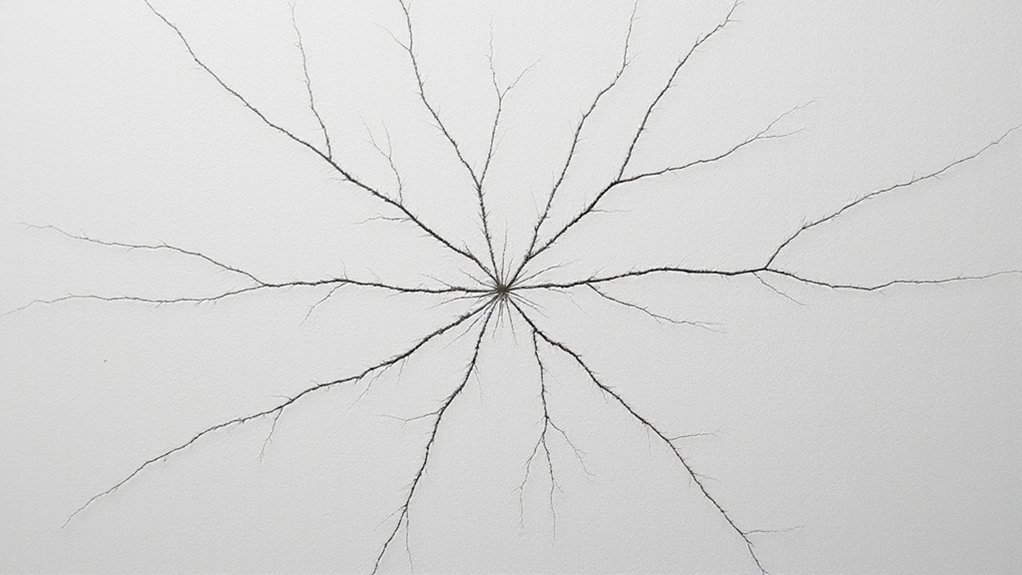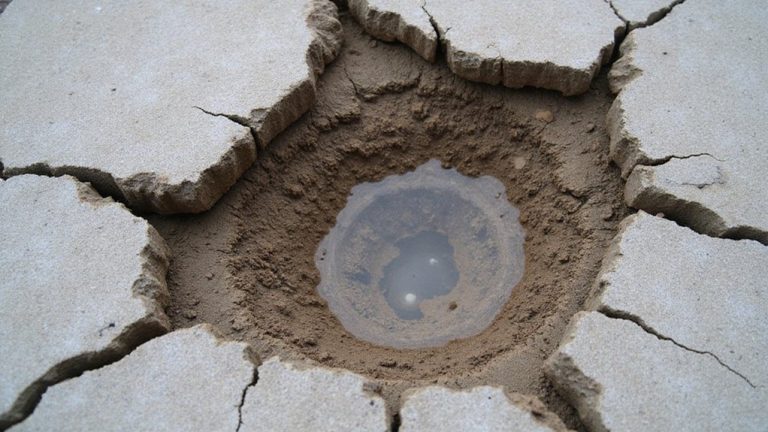Wall cracks can send shivers down any homeowner's spine, triggering immediate worry about potential structural damage. You might notice these unsettling lines appearing suddenly, causing you to wonder about their significance. Not all cracks spell disaster, but some could indicate serious foundation issues. Understanding the differences can save you thousands in potential repairs and provide peace of mind. Want to learn how to distinguish between harmless settlement lines and red-flag warning signs?
Types of Wall Cracks and Their Characteristics
When you first notice a crack in your wall, it's natural to feel worried about what it might mean. Different crack patterns can signal various structural flaws in your home. Foundation settlement can cause different types of cracks that may indicate varying levels of structural concern. Vertical cracks are often less serious and might result from normal house settling. Horizontal cracks, however, could indicate more significant foundation problems that require professional assessment. Hairline cracks are typically cosmetic, while wider fissures might suggest underlying structural issues. Understanding these variations can help you determine whether you need immediate professional intervention or can simply patch the wall. Your home's integrity depends on careful observation and timely action.
Understanding House Settling and Normal Structural Movement
Why do houses develop cracks over time? It's a natural process related to normal thermal expansion and seasonal temperature changes. Your home's materials—wood, drywall, and concrete—expand and contract as temperatures shift, causing slight movements that can create hairline cracks. Foundation cracks and movement can sometimes indicate more serious structural issues that may require professional assessment by experienced foundation repair contractors.
These aren't usually signs of serious structural problems, but rather normal settling that happens with age. Most homes experience some degree of movement, especially during dramatic weather shifts. Understanding these changes can help you distinguish between harmless hairline cracks and potentially serious structural issues that might need professional attention.
Warning Signs of Serious Foundation Problems
How can you tell if those cracks in your walls signal a serious foundation problem? Shifting soil conditions and inadequate drainage systems often cause significant structural damage.
You'll want to look for warning signs like diagonal cracks wider than 1/4 inch, doors that won't close properly, or uneven floor surfaces. Exterior foundation cracks, especially those running vertically or in a stair-step pattern, could indicate serious underlying issues.
If you're noticing multiple symptoms, it's time to call a professional foundation inspector who can assess potential risks and recommend appropriate repairs.
Factors That Contribute to Wall Cracking
Understanding the root causes of wall cracks goes beyond identifying foundation problems. Your home's structural integrity can be compromised by factors like soil composition variations and uneven load distribution.
Different soil types expand and contract with moisture changes, creating pressure that shifts your foundation. Poorly compacted ground or areas with clay-heavy soil are especially vulnerable.
When weight isn't evenly distributed across your home's structure, stress concentrates in specific areas, causing walls to develop unsightly fissures. Recognizing these factors helps you diagnose potential issues before they become major repairs.
DIY Assessment of Wall Crack Severity
Because wall cracks can signal anything from minor cosmetic issues to serious structural problems, homeowners need a systematic approach to evaluate their severity. Start by measuring visible cracks over time, using a ruler or tape measure to track width and length. Document each crack's location, taking clear photos for comparison.
Monitor crack progression monthly, noting any changes in size or direction. Hairline cracks under 1/8 inch are typically harmless, while wider cracks might indicate foundation issues. If you're unsure about a crack's significance, consider consulting a professional who can provide expert assessment and peace of mind.
Professional Inspection and Repair Strategies
Most homeowners will encounter wall cracks that require professional evaluation at some point, making expert inspection a critical step in maintaining your home's structural integrity. A qualified contractor can perform an extensive structural assessment, identifying potential underlying issues that mightn't be visible to the untrained eye.
They'll use specialized tools and techniques to determine whether your cracks signal minor cosmetic damage or serious structural problems. By investing in professional evaluation, you'll gain peace of mind and potentially prevent costly future repairs. Don't hesitate to seek expert guidance when wall cracks concern you.
Preventative Measures to Minimize Wall Damage
While wall cracks can be alarming, homeowners can take several proactive steps to prevent and minimize potential structural damage. Effective moisture management is vital; you'll want to guarantee proper drainage around your home's foundation and fix any leaks promptly.
Maintain good air circulation in your living spaces to reduce humidity levels that can contribute to wall stress. Regularly inspect your home's exterior and interior for early signs of potential issues. Monitor soil conditions around your foundation, and consider professional landscaping advice to prevent ground movement that might compromise your walls' stability.
Cost Considerations for Wall Crack Repairs
How much will wall crack repairs set you back? The cost varies widely, depending on the severity and underlying cause. Budget-friendly options exist for minor cracks, often ranging from $50 to $500.
More extensive damage might require professional intervention, potentially costing $1,000 to $5,000. Cost-effective solutions include DIY repair kits and targeted patching techniques. You'll want to assess the crack's size, location, and potential structural implications before deciding on a repair strategy.
Frequently Asked Questions
Can Wall Cracks Appear Suddenly, or Do They Develop Gradually?
Wall cracks can develop gradually or appear suddenly, often influenced by seasonal expansion. You'll notice they're typically slow-moving, but sometimes structural shifts can create unexpected fissures in your home's walls.
Do Different Types of Home Foundations Cause Varying Crack Patterns?
Your home's foundation design and local soil conditions directly influence wall crack patterns. Different foundations – slab, pier-and-beam, or basement – can cause unique stress lines that determine how and where cracks emerge.
What Makes Old House Walls More Prone to Cracking?
You'll find old house walls crack more due to moisture issues and temperature fluctuations, which cause materials to expand, contract, and gradually weaken your home's structural integrity over decades.
Are Hairline Cracks Always Harmless, or Should I Be Concerned?
Hairline cracks aren't always harmless. They're often caused by expansion joint locations and seasonal temperature changes. If they're thin and don't widen, you're likely safe, but monitor them closely for peace of mind.
How Quickly Can Wall Cracks Compromise My Home's Structural Integrity?
Foundation settling concerns can quickly compromise your home's structural integrity if underlying soil conditions worsen. You'll want to monitor crack progression and consult a professional to prevent potential damage escalating beyond repair.



